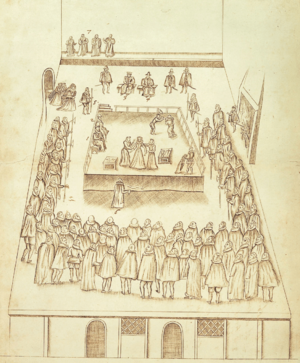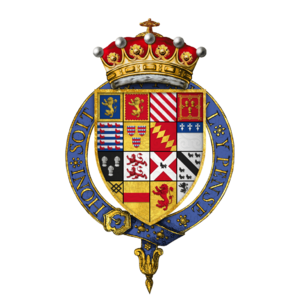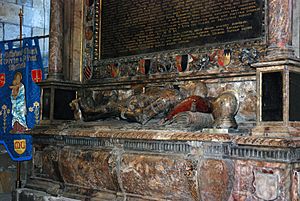George Talbot, 6th Earl of Shrewsbury facts for kids
Quick facts for kids
George Talbot
|
|
|---|---|
| 6th Earl of Shrewsbury | |
 |
|
| Born | about 1522 or 1528 |
| Died | 18 November 1590 |
| Buried | Sheffield Cathedral |
| Spouse(s) | Lady Gertrude Manners Elizabeth Hardwick |
| Issue | Lord Francis Talbot Gilbert Talbot, 7th Earl of Shrewsbury Edward Talbot, 8th Earl of Shrewsbury Catherine Talbot Mary Talbot Grace Talbot |
| Father | Francis Talbot, 5th Earl of Shrewsbury |
| Mother | Mary Dacre |

George Talbot, 6th Earl of Shrewsbury (born around 1522 or 1528 – died 18 November 1590) was an important English noble and military leader. He is most famous for being the person in charge of Mary, Queen of Scots for many years, from 1568 to 1585. He was also known for his marriage to his second wife, Bess of Hardwick, a very powerful and wealthy woman of her time.
Contents
Life and Important Roles
George Talbot was the only son of Francis Talbot, 5th Earl of Shrewsbury. When he was young, he served in the military. He fought in Scotland and helped protect the English border.
Becoming an Earl
In 1560, George inherited his father's important titles, including the Earldom of Shrewsbury. This made him a very powerful person in England. He also took over his father's job as the Chamberlain of the Exchequer, which was a high-ranking financial role. A year later, he was made a Knight of the Garter, a special honor given by the monarch.
Guarding Mary, Queen of Scots
One of George Talbot's most important jobs was guarding Mary, Queen of Scots. Queen Elizabeth I imprisoned Mary in 1568 after Mary fled to England from Scotland.
Shrewsbury first received Mary at Tutbury Castle in February 1569. He moved her between several of his homes and castles to keep her safe and prevent anyone from trying to rescue her. These places included Wingfield Manor, Tutbury again, and Chatsworth.
In 1570, Mary was moved to Sheffield Castle, which was Shrewsbury's main home. She stayed there for about fourteen years, only leaving for short trips to places like Buxton or Chatsworth. During this time, there were many plans to free Mary, but Shrewsbury always managed to stop them.
Important Trials and Events
Shrewsbury held other important positions too. In 1571, he was the Lord High Steward for the trial of Thomas Howard, 4th Duke of Norfolk. This trial was about a plot against Queen Elizabeth. In 1572, Shrewsbury became the Earl Marshal, another very high-ranking position, which he held until his death.
After Mary, Queen of Scots, was found guilty of being part of a plot against Queen Elizabeth (the Babington Plot), Shrewsbury was one of the official people who saw her execution. This happened at Fotheringhay Castle on 8 February 1587.
Personal Life and Health
After his first wife, Gertrude Manners, passed away, George Talbot married Bess of Hardwick in 1568. This was a double wedding, meaning their two oldest children from previous marriages also got married at the same time. Bess was a very strong-willed and successful woman. She even had her new initials, "ES" (Elizabeth Shrewsbury), carved into her magnificent house at Hardwick Hall.
Queen Elizabeth I made Shrewsbury responsible for guarding Mary, Queen of Scots, for over 15 years. This was a very demanding job. Over time, his marriage with Bess of Hardwick faced some disagreements, partly because of the stress of guarding Mary and money issues.
Shrewsbury also suffered from poor health, including a painful condition called rheumatism. This caused him chronic pain and made him feel unwell. Queen Elizabeth tried to help him and Bess fix their disagreements, but Shrewsbury remained unhappy. He spent his final years without Bess.
George Talbot died on 18 November 1590. He was buried at Sheffield Cathedral, where you can still see a large monument built in his honor.
Marriages and Children
George Talbot was married twice:
- First, he married Gertrude Manners. She was the daughter of Thomas Manners, 1st Earl of Rutland. They had several children, including:
- Francis, Lord Talbot, who was his oldest son. He passed away before his father.
- Gilbert Talbot, 7th Earl of Shrewsbury, who became the next Earl after his father.
- Henry Talbot.
- Edward Talbot, 8th Earl of Shrewsbury, who became the Earl after his brother Gilbert.
- Catherine Talbot, who married Henry, Lord Herbert.
- Mary Talbot.
- Grace Talbot, who married her step-brother Henry Cavendish.
- Second, he married Elizabeth Hardwick (around 1527 – 1608). She was a wealthy widow from Hardwick Hall. They did not have any children together.
Letters and Other Writings
George Talbot left behind many letters and papers. These writings cover the time from when he became an Earl in 1560 until his death. Many of his papers are now kept in special libraries, like the Lambeth Palace library.
Scholars today find it hard to read Shrewsbury's handwriting because it was very messy. He even mentioned himself that his writing was "evil favoured." This was made worse because spelling rules were not as strict back then. It is believed that his painful hand condition, rheumatism, made his handwriting even harder to read.
In Fiction
George Talbot is a character in several historical novels and plays:
- He appears in The Captive Queen of Scots by Jean Plaidy.
- He is also in The Other Queen by Philippa Gregory.
- He is a character in Friedrich Schiller's play Mary Stuart.
- He is also in the opera Maria Stuarda by Gaetano Donizetti.





